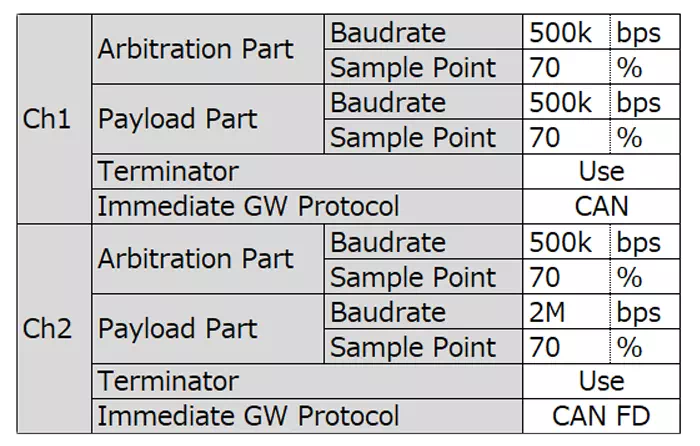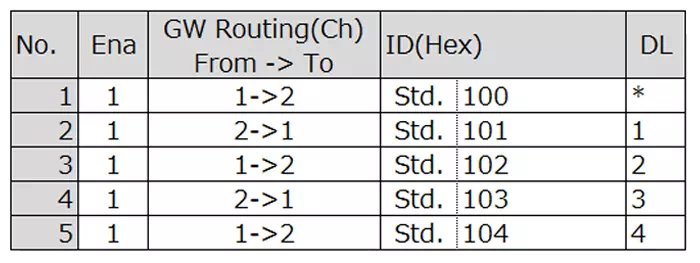Gateway Setting File Specifications and Sheet Guide
MicroPeckerX InstaGW is configured with an Excel-format gateway setting file. This section explains the file specifications and how to enter configuration values.
The gateway setting file template (ConfigTemplate.xlsx) is included in the MicroPeckerX InstaGW package folder.
Copy the template to any working folder before editing it.
Gateway Setting File Specifications
Sheet order
The Excel sheets must appear in the order Com, Immediate GW, Gateway, Periodic Frame. Additional sheets can be appended afterwards.

Settings on the "Com" sheet
Use the Com sheet to configure communication parameters. These settings are mandatory.

| Item | Description | Setting values | |
|---|---|---|---|
| Arbitration Part | Baudrate | Baud rate for the arbitration phase | Select from 125k, 250k, 500k, 1M |
| Sample Point | Sample point for the arbitration phase | Select from 60%, 65%, 70%, 75%, 80%, 85% | |
| Payload Part | Baudrate | Baud rate for the data phase | Select from 500k, 1M, 2M, 4M, 5M |
| Sample Point | Sample point for the data phase | Select from 60%, 65%, 70%, 75%, 80%, 85% | |
| Terminator | Enable or disable the termination resistor | Select Use or Not Use | |
| Immediate Gateway Protocol | Protocol used when performing an immediate gateway transmission | Select CAN or CAN FD | |
When the arbitration and data-phase baud rates appear in the combinations below, the data-phase baud rate is automatically corrected.
| Arbitration-phase baud rate | Data-phase baud rate | |
|---|---|---|
| Before correction | After correction | |
| 125 kbps | 1 Mbps, 2 Mbps, 4 Mbps, 5 Mbps | 500 kbps |
| 250 kbps | 4 Mbps, 5 Mbps | 2 Mbps |
| 1 Mbps | 500 kbps | 1 Mbps |
If the data-phase baud rate and sample point are set to the following combinations, the data-phase sample point is automatically adjusted.
| Data-phase baud rate | Data-phase sample point | |
|---|---|---|
| Before correction | After correction | |
| 2 Mbps, 4 Mbps | 65%, 75%, 85% | 5% lower than configured (60%, 70%, 80%) |
| 5 Mbps | 60%, 65%, 70%, 80%, 85% | 75% |
Settings on the "Immediate GW" sheet
The Immediate GW sheet configures immediate gateway behavior.
Immediate gateway uses a hardware-based gateway process, enabling ultra-low-latency forwarding. You can configure up to 32 IDs for each direction (CH1→CH2 and CH2→CH1).
When a specified ID is received, MicroPeckerX transmits a frame with the same ID on the other channel using the specified protocol and DLC. You can also specify gateway IDs and DLCs with wildcard notation using the asterisk symbol.

| Item | Description | Setting values |
|---|---|---|
| Ena | Enable or disable the configuration row | Select 0 (disable) or 1 (enable) |
| GW Routing (Ch) From -> To | Direction of the gateway (channel) | Select 1->2 or 2->1 |
| ID (Hex) | ID to gateway | Enter the value in hexadecimal. Select the format (Std. for standard ID, Ext. for extended ID) from the left cell. |
| DL | DLC to gateway | Select *, 1, 2, 3, 4, 5, 6, 7, 8, 12, 16, 20, 24, 32, 48, 64 |
For immediate gateway, the destination protocol (CAN or CAN FD) is identical to the Immediate Gateway Protocol selected on the communication settings sheet. If the destination protocol is CAN, the data length is handled as follows.
| Source protocol | Data length |
|---|---|
| CAN | Unchanged |
| CAN FD | First 8 bytes (data is truncated to 8 bytes) |
Immediate gateway will forward CAN FD frames that arrive from a node in the error-passive state (frames with ESI = 1). These frames are filtered in normal gateway mode.
Settings on the "Gateway" sheet
Use the Gateway sheet to configure normal gateway behavior.

Normal gateway runs as a software process on MicroPeckerX. It allows you to delay transmissions or remap IDs between source and destination channels.
You can configure up to 64 IDs in total for CH1→CH2 and CH2→CH1 forwarding.
When a specified ID is received, MicroPeckerX transmits a frame on the other channel using the configured protocol, ID, and DLC. Transmission timing can also be delayed.
| Item | Description | Setting values | |
|---|---|---|---|
| Ena | Enable or disable the configuration row | Select 0 (disable) or 1 (enable) | |
| GW Routing (Ch) From -> To | Direction of the gateway (channel) | Select 1->2 or 2->1 | |
| GW From | Protocol | Source protocol | Select CAN or CAN FD |
| ID (Hex) | Source ID | Enter the value in hexadecimal. Select the format (Std. for standard ID, Ext. for extended ID) from the left cell. | |
| DL | Source DLC | Select 1, 2, 3, 4, 5, 6, 7, 8, 12, 16, 20, 24, 32, 48, 64 | |
| GW To | Protocol | Destination protocol | Select CAN or CAN FD |
| ID (Hex) | Destination ID | Enter the value in hexadecimal. Select the format (Std. for standard ID, Ext. for extended ID) from the left cell. | |
| DL | Destination DLC* | Select 1, 2, 3, 4, 5, 6, 7, 8, 12, 16, 20, 24, 32, 48, 64 | |
| Delay (ms) | Delay between receiving on the source channel and transmitting on the destination channel | Enter an integer value (milliseconds) | |
If the destination DLC is shorter than the source DLC, excess data is truncated. (Example: when the source DLC is 8 and the destination DLC is 5, bytes D6 and later are discarded.)
Settings on the "Periodic Frame" sheet
Use the Periodic Frame sheet to configure periodic transmissions. MicroPeckerX InstaGW can send frames periodically on any channel.
Periodic transmission can run in parallel with gateway processing, enabling MicroPeckerX to act as a stand-alone simulation node.

| Item | Description | Setting values | |
|---|---|---|---|
| Ena | Enable or disable the configuration row | Select 0 (disable) or 1 (enable) | |
| Ch | Transmit channel | Select 1 (CH1) or 2 (CH2) | |
| ID (Hex) | ID to transmit | Enter the value in hexadecimal. Select the format (Std. for standard ID, Ext. for extended ID) from the left cell. | |
| Protocol | Transmit protocol | Select CAN or CAN FD | |
| DL | Transmit DLC | Select 1, 2, 3, 4, 5, 6, 7, 8, 12, 16, 20, 24, 32, 48, 64 | |
| Timing | Cycle (ms) | Transmission cycle | Enter an integer value (milliseconds) |
| Offset (ms) | Transmission offset | Enter an integer value (milliseconds) | |
| Data (Hex) | D1–D64 | Transmit data* | Enter hexadecimal values |
You do not need to enter data beyond the configured DLC. (Example: when the DLC is 8, values D9 and later are unnecessary.)